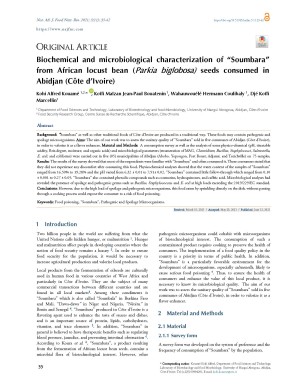Biochemical and microbiological characterization of “Soumbara” from African locust bean (Parkia biglobosa) seeds consumed in Abidjan (Côte d’Ivoire)
Abstract
Background: “Soumbara” as well as other traditional foods of Côte d'Ivoire are produced in a traditional way. These foods may contain pathogenic and spoilage microorganisms. Aims: The aim of our work was to assess the sanitary quality of “Soumbara” sold in five communes of Abidjan (Côte d’Ivoire), in order to valorize it as a flavor enhancer. Materials and Methods: A consumption survey as well as the analysis of some physico-chemical (pH, titratable acidity, Brix degree, moisture, and organic acids) and microbiological parameters (enumeration of MAG, Clostridium, Bacillus, Staphylococci, Salmonella, E. coli, and coliforms) were carried out in five (05) municipalities of Abidjan (Abobo, Yopougon, Port Bouet, Adjamé, and Treichville) on 75 samples. Results: The results of the survey showed that most of the respondents were familiar with “Soumbara” and often consumed it. These consumers stated that they did not experience any discomfort after consuming this food. Physicochemical analyses showed that the water content of the samples of “Soumbara” ranged from 16.50% to 19.28% and the pH varied from 6.32 ± 0.01 to 7.91± 0.02. “Soumbara” contained little follow-through which ranged from 0.10 ± 0.001 to 0.27 ± 0.05. “Soumbara” also contained phenolic compounds such as coumarins, hydroquinones, and caffeic acid. Microbiological analyses had revealed the presence of spoilage and pathogenic germs such as Bacillus, Staphylococcus, and E. coli at high loads exceeding the 2019/229/EC standard. Conclusions: However, due to the high load of spoilage and pathogenic microorganisms, this food eaten by sprinkling directly on the dish, without passing through a cooking process could expose the consumer to a risk of food poisoning.
Full text article
Authors
Copyright (c) 2021 Authors

This work is licensed under a Creative Commons Attribution 4.0 International License.
-
Attribution — You must give appropriate credit, provide a link to the license, and indicate if changes were made. You may do so in any reasonable manner, but not in any way that suggests the licensor endorses you or your use.
-
No additional restrictions — You may not apply legal terms or technological measures that legally restrict others from doing anything the license permits.





